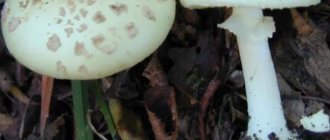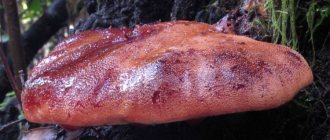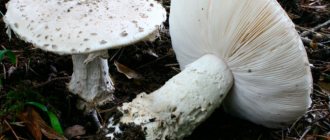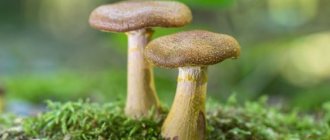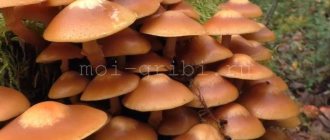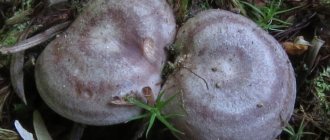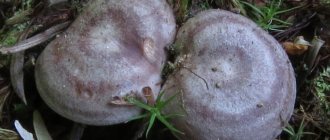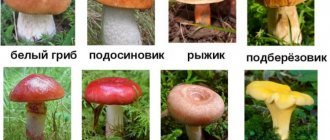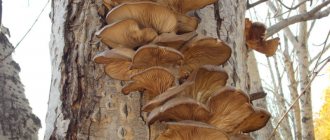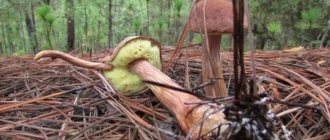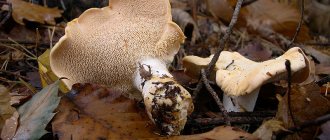Types of blackheads, appearance
The boletus mushroom (blackhead) is an edible species; it belongs to the genus Obabkov from the Boletaceae family. All of its representatives are edible, differing slightly in appearance and taste. In the temperate climate of Eurasia, the common duncap is the most common.
Other types found, brief description:
- Common duncap, a mushroom that is found more often than others. The dark-colored cap reaches 15-16 cm in diameter, underneath it there is a spongy layer of white and yellow tubes. The stem of the mushroom, covered with black scales, has a different color (lighter than that of the cap) and can be long (up to 12 cm). This predominantly autumn mushroom grows in birch groves, mixed and deciduous forests.
- The gray boletus (hornbeam) has a different cap color: from gray, ash to ocher, beige. During the hot, dry season, the mushroom caps dry out and crack. It often grows in the Caucasus and central Russia, preferring hornbeam forests. The color of the pulp is light yellow, when cut it changes to purple or black.
- Swamp (white) subspecies with a cap colored brown; the stem of the mushroom is slightly lighter (often completely white). It grows up to 12 cm in height, the white flesh does not change color when cut. Grows in damp, swampy areas near the roots of trees (mainly next to birch trees).
- The boletus is multi-colored - its habitat is most often found in birch groves or oak groves, next to poplars. The color of the cap can be either light (beige, pinkish) or dark (brown, brick). On the break, the flesh of the cap is pink, and the legs have a bluish tint.
- Blackhead (checkerboard) is found in birch and pine forests. Loves damp places. The mushroom cap is dark brown or black. Small black scales are visible on the stem.
- The pink boletus (oxidizing) got its name because the flesh turns pink when broken. Juveniles are distinguished by a strong round black cap. As it grows, the color of the cap changes to gray. The mushroom settles in damp birch forests.
- The harsh subspecies differs from others in its pulp having a sweetish taste. The hat is painted in gray, brown, and purple tones. Young mushrooms have caps that are pubescent and covered with scales. This sign disappears as they grow. The species grows on calcareous soils.
- Tundra boletus grows at the roots of dwarf birches in the tundra zone. The mushroom cap is always very light (due to lack of lighting) and has a small diameter.
Common boletus
The cap of this mushroom is brown, sometimes with a brown or red tint.
This largely depends on the place where it grows. The leg is juicy, hard with black scales, thickening near the ground.
Where, when and how does it grow
The common boletus (photo below) forms a symbiosis with birch trees and is widespread on both American continents and on the continent of Eurasia in a humid temperate climate. Mushrooms inhabit birch, deciduous and mixed forests; they love moss-covered soils with thick grass.
Mushroom picking begins at the end of summer (rarely in the middle), continuing throughout the fall. Maximum fruiting occurs in September. Birch trees grow mainly in groups. The Obabok genus is distinguished by very rapid growth, adding four cm in height per day; full ripening occurs on days 5-6; at a week of age, the mushroom is considered already old. See what the boletus mushroom looks like, description and photos, pictures you will find in our review.
Father to father - discord
The culinary qualities of the mushroom are impeccable, and it can be found almost throughout Russia in birch or mixed forests from May to October.
The boletus mushroom, or as it is also called, obabok, has several types. All of them are edible, but differ slightly in taste.
Benefit
Boletus is a tasty, healthy mushroom. Low calorie content makes it popular for dietary, vegetarian nutrition. In a low-calorie menu, mushrooms replace meat, and it is recommended to prepare dishes from already dried mushrooms that have gotten rid of the chitin substance.
The high content of vitamins and minerals is used for medical purposes. Blackhead has a beneficial effect on the central nervous system, regulates blood sugar levels, helps remove toxic substances from the body, improving the functioning of the liver and kidneys.
Marsh boletus
This type of mushroom grows in very moist soils. Color: light gray or dark yellow.
Unlike an ordinary obedok, its leg is thin. The pulp is fatty and soft. The taste is excellent.
Application
In cooking
The blackhead mushroom is suitable for preparing different types of dishes: first, second, appetizers, sauces. It is also prepared for future use. In terms of nutritional value, the boletus mushroom is second only to the porcini mushroom. A small disadvantage is that when cooked, its flesh darkens.
In medicine
In fungotherapy, it is believed that boletus mushrooms improve blood circulation, strengthen the myocardium, increase immunity, stimulate the thyroid gland, counteract cancer cells, and help in the treatment of skin diseases. Official medicine does not use blackhead.
Boletus is harsh
The cap of the stiff boletus can be either gray, brown or purple. In old mushrooms it is smooth, but in young specimens it is scaly. The leg is smooth, white with a brown tint near the ground.
The mushroom has a very bright smell, and dishes made from it have a sweet taste. When mechanically applied to fresh pulp, it quickly darkens.
How to distinguish edible from inedible
The Obabok genus has a very unpleasant double, outwardly similar to its representatives.
This is a gall mushroom that has a very bitter taste; even one such mushroom will ruin the entire dish. Bile mushrooms are not poisonous, but absolutely inedible. What are the differences: the gall fungus turns red at the incision site and has an unpleasant odor.
The layer under the cap is colored pinkish, the flesh has the structure of lard, and there is a mesh on the stem, while in boletus mushrooms the stem is always covered with scales. Gall mushrooms settle near ditches, stumps, and even grow in dark coniferous forests, which is not typical for boletus mushrooms. Sometimes boletus is confused with blackhead, which is not scary, since boletus is edible. Boletus differs from boletus in the color of the flesh at the break. See photos, blackhead mushrooms, in the collection below.
Interesting Facts
Black boletus.
- Experienced mushroom pickers say that the appearance of black boletus in the forests is a sure sign that the autumn honey fungus harvesting season has begun.
- The productivity of boletus is still a somewhat mysterious phenomenon. This mushroom can bear fruit within the average amount for several years, then unexpectedly “shoot out” one year, striking homeric quantities of mushrooms in the forest, and then completely disappear for several years or return to normal yield.
Nutritional value and chemical composition
The energy value of fresh boletus is 20 kcal/100 grams of product, dried 230 kcal/100 grams. The composition of the mushroom pulp includes:
- proteins – 35%;
- fats – 4%;
- sugar – 14%;
- food cellulose (fiber) – 25%.
The pulp of blackheads contains vitamins and minerals (including the trace element cobalt), essential amino acids (leucine, arginine, etc.), and various organic acids.
Boletus in a summer cottage
You can grow obabkas yourself if birch trees grow in your summer cottage or next to a fence.
To do this, you need to make an aqueous solution with fungal spores. Carefully removing the turf from the birch roots, water them with this solution. Subsequently, the mycelium must be darkened and periodically moistened.
You will have to wait a long time for the harvest, but one day you will unexpectedly be happy! There are many photos of boletus mushrooms grown at home on social networks.
Poisoning
There is an opinion among experienced mushroom pickers that false boletus is not eaten because of its incredible bitterness. Poisoning by this mushroom has not been proven by scientists. Or rather, they cannot come to a common opinion. Some experts claim that the bitterness of false boletus is not dangerous to humans. Others are sure that its pulp contains toxins that can be absorbed into the blood even when touching the mushroom. After this, they gradually penetrate into the internal organs, destroying them.
Therefore, when going on a quiet hunt, study well edible mushrooms and their counterparts. To avoid unpleasant consequences, do not collect mushrooms that cause the slightest suspicion in you.
LiveInternetLiveInternet
—Categories
- (1)
- (0)
- ARCHIVE (3)
- FRAMES (1)
- ASTROLOGY (61)
- ASTRONOMY (29)
- HYPOTHESES (4)
- AUDIOBOOKS (5)
- UNCLASSIFIED (48)
- VIDEO (128)
- VALENTINA KOGUT (1)
- VIRTUAL TOURS (36)
- ALWAYS AT HAND (49)
- MONEY (20)
- CHILDREN (10)
- DESIGN, DAY DECORATION (85)
- COMMENTS (4)
- FOR CREATIVITY (207)
- COMMENTS-PICTURES (12)
- PETS (4)
- MYSTERIES OF NATURE (12)
- EARN (7)
- HEALTH (791)
- ALCOHOLISM, DRUG ADDICTION (32)
- MEDICINES (9)
- INTERESTING (132)
- INTERESTING (58)
- ART BEAUTY (63)
- ROOM FLOWERS (21)
- COOKING (414)
- BAKERY (65)
- HOMEMADE DELICACIES (29)
- BLANKS (16)
- SNACKS (23)
- FIRST COURSES (2)
- SALADS (22)
- CULTURE (18)
- THE WORLD AROUND US (270)
- ANIMALS (108)
- NATURE (73)
- BIRDS (12)
- MY MOTHERLAND - USSR (26)
- MY RUSSIA (199)
- KALUGA - MY HOMELAND (10)
- MOSCOW (2)
- THE TRUTH OF OUR LIVES (84)
- MUSIC CARDS (5)
- MUSIC (130)
- ANCESTORS' LEGACY (315)
- GODS, SPIRITS, MYTHS (1)
- GODS, SPIRITS, MYTHS (45)
- TRADITIONS (42)
- LANGUAGE (9)
- SCIENCE (32)
- LIBRARY (14)
- ENCYCLOPEDIA (6)
- OUR REALITY (85)
- THE UNKNOWN (208)
- MYSTERIES OF HISTORY (23)
- INFERNO (11)
- NEW YEAR'S (8)
- NEW KNOWLEDGE (248)
- EXPLORE (9)
- HISTORY (96)
- LION FUSH (5)
- ABOUT MUSHROOMS (7)
- IN MEMORY OF IDOLS (14)
- PLAYERS (4)
- WISHES (46)
- CONGRATULATIONS (256)
- COMPUTER USE (86)
- USEFUL TIPS (89)
- USEFUL LINKS (73)
- POLITICS (279)
- ECONOMY (93)
- LET'S HELP (24)
- LIKED (21)
- PARABLES, QUOTES (23)
- PSYCHOLOGY (625)
- VECTOR PSYCHOLOGY (28)
- IMPACT (68)
- FOR OLI (4)
- PSYCHOSOMATICS (32)
- MOURNING (2)
- TRAVEL (0)
- FRAMES (521)
- FOR VIDEO (3)
- WINTER (25)
- CULINARY (3)
- CONGRATULATIONS (4)
- FLORAL BACKGROUND (13)
- RELIGION (96)
- GREAT Rus' (32)
- GARDEN, VEGETABLE GARDEN (402)
- MOST NEEDED LINKS (7)
- SOCIAL NETWORKS (2)
- POEMS (307)
- SCHEMES FOR DESIGN (455)
- DECORATIONS (303)
- GIRLS (1)
- NEXT BUTTONS (25)
- NEW YEAR'S (149)
- SEPARATORS (4)
- LESSONS ON LYRA (137)
- PHILOSOPHY OF MYSTICITY (7)
- FLOWERS (45)
- QUOTES AND APHORISMS (13)
- CLEAN COMPUTER (20)
- TO BE REMEMBERED (76)
- WHEN THE SOUL SCREAMS (1)
- ESOTERICA (468)
- INFORMATIVE MYSTIC (40)
- INFERNO (3)
- KARMA (46)
- MAGIC (26)
- DESTINY (23)
- TAROT (2)
- ENERGY (53)
- EPIGRAPH (66)
- HUMOR (90)
- LEGAL ADVICE (122)
